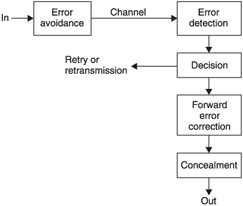3.11 Basic Error Correction
| | ||
| | ||
| | ||
3.11 Basic Error Correction
There are many different types of transmission channel and consequently there will be many different mechanisms that may result in errors. Bit errors in audio cause unpleasant crackles. In video they cause 'sparkles' in the picture whose effect depends upon the significance of the affected bit. Errors in compressed data are more serious as they may cause the decoder to lose sync.
Errors may be caused by outside interference, or by Gaussian thermal noise in the channel and receiver. When group codes are used, a single defect in a group changes the group symbol and may cause errors up to the size of the group. Single-bit errors are therefore less common in group -coded channels. Inside equipment, data are conveyed on short wires and the noise environment is under the designer's control. With suitable design techniques, errors can be made effectively negligible whereas in communication systems, there is considerably less control of the electromagnetic environment. In networks, packets may be lost.
Irrespective of the cause, all these mechanisms cause one of two effects. There are large isolated corruptions, called error bursts, where numerous bits are corrupted all together in an otherwise error-free area, and there are random errors affecting single bits or symbols. Whatever the mechanism, the result will be that the received data will not be exactly the same as those sent. In binary the discrete bits will be each either right or wrong. If a binary digit is known to be wrong, it is only necessary to invert its state and then it must be right. Thus error correction itself is trivial; the hard part is working out which bits need correcting.
There are a number of terms having idiomatic meanings in error correction. The raw BER (bit error rate) is the error rate of the medium, whereas the residual or uncorrected BER is the rate at which the error-correction system fails to detect or miscorrects errors. In practical digital systems, the residual BER is negligibly small. If the error correction is turned off, the two figures become the same.
Error correction works by adding some bits to the data that are calculated from the data. This creates an entity called a codeword spanning a greater length of time than one bit alone. The statistics of noise means that whilst one bit may be lost in a codeword, the loss of the rest of the codeword because of noise is highly improbable. As will be described later in this chapter, codewords are designed to be able to correct totally a finite number of corrupted bits. The greater the time span over which the coding is performed, the greater will be the reliability achieved, although this does mean that an encoding delay will be experienced , along with a similar or greater decoding delay.
Shannon 3 disclosed that a message could be sent to any desired degree of accuracy provided that it is spread over a sufficient time span. Engineers have to compromise, because an infinite coding delay in the recovery of an error-free signal is not acceptable.
In some applications, such as AES/EBU and SDI, the requirements of production are such that no delay is acceptable. Such interfaces cannot use error correction and so are designed to be so robust that errors are negligibly infrequent in normal use. Instead of error correction, error detection is employed. If errors are detected , this implies that some maintenance is required.
If error correction is necessary as a practical matter, it is then only a small step to put it to maximum use. All error correction depends on adding bits to the original message, and this, of course, increases the number of bits to be sent, although it does not increase the information. It might be imagined that error correction is going to reduce efficiency, because bandwidth has to be found for all the extra bits. Nothing could be further from the truth. Once an error-correction system is used, the signal-to-noise ratio of the channel can be reduced, because the raised BER of the channel will be overcome by the error-correction system. Consequently the power of a digital transmitter can be reduced if error correction is used.
Figure 3.17 shows the broad subdivisions of error handling. The first stage might be called error avoidance and includes such measures as network rerouting to bypass faulty links. Properly terminating network cabling is also in this category. The data pass through the channel, which causes whatever corruptions it will. On receipt of the data the occurrence of errors is first detected, and this process must be extremely reliable, as it does not matter how effective the correction or how good the concealment algorithm, if it is not known that they are necessary. The detection of an error then results in a course of action being decided.

Figure 3.17: Error-handling strategies can be divided into avoiding errors, detecting errors and deciding what to do about them. Some possibilities are shown here. Of all these the detection is the most critical, as nothing can be done if the error is not detected.
In the case of a file transfer, real-time operation is not required. A packet in error in a network may result in a retransmission. In many cases of digital video or audio replay a retransmission is not possible because the data are required in real time. In this case the solution is to encode the message using a system sufficiently powerful to correct the errors in real time. These are called forward error-correcting schemes (FEC). The term 'forward' implies that the transmitter does not need to take any action in the case of an error: the receiver will perform the correction.
| | ||
| | ||
| | ||
EAN: 2147483647
Pages: 120